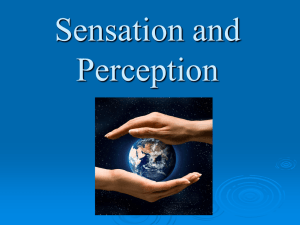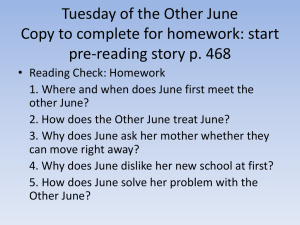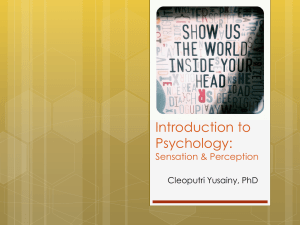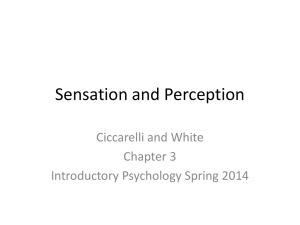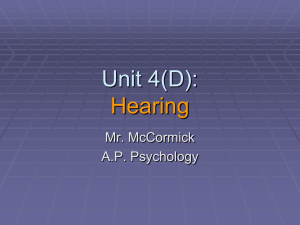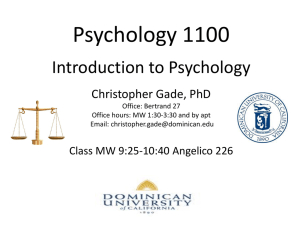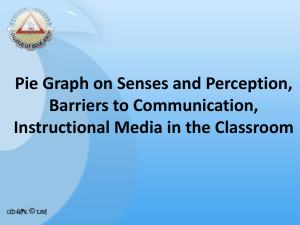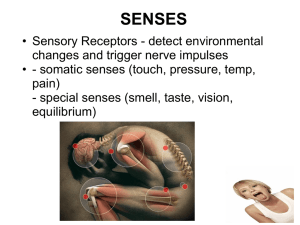Sensation and Perception Unit IV
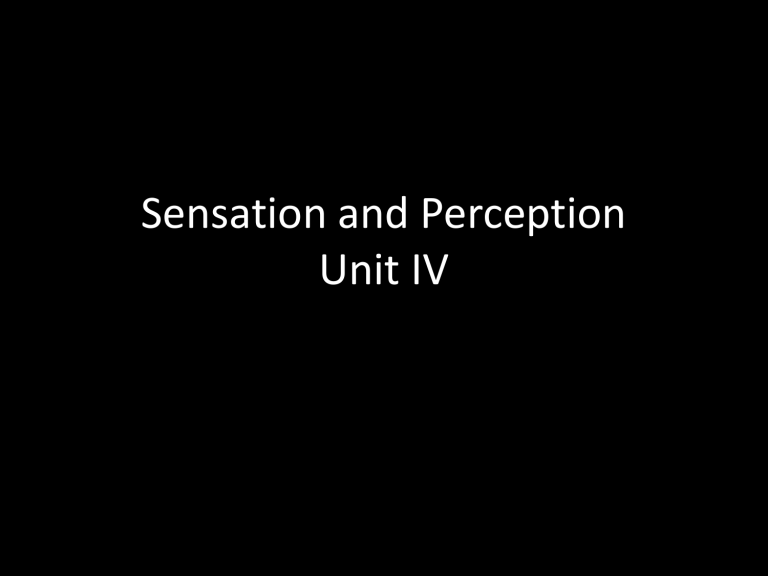
Sensation and Perception
Unit IV
Sensation and Perception
• Frogs have cells in their eyes that fire only in response to small, dark, moving objects. A frog could starve to death knee deep in motionless flies. The second the fly moves the frog’s bug detector cells snap awake
• Male silkworm moths’ odor receptors can detect one billionth of an ounce of sex attractant per second released by a female one mile away
• Human ears are most sensitive to sound frequencies that include human voices, especially a baby’s cry *
Sensation and Perception
• Sensation- the process by which our sensory receptors and nervous system receive and represent stimulus energies from our environment
• Perception- the process of organizing and interpreting sensory information, enabling us to recognize meaningful objects and events
• Everyday, our sensation and perception blend into one continuous process*
Sensation and Perception
• Bottom-up processing- analysis that begins with the sensory receptors and works up to the brain’s integration of sensory information
– Enables our sensory systems to detect the lines, angles, and colors that form the flower and leaves
• Top-down processing- information processing guided by higher level mental processes, as when we construct perceptions drawing on our experience and expectations
– Interprets what our senses detect *
Sensation and Perception
• Selective attention- the focusing of conscious awareness on a particular stimulus
– Its like a flashlight beam
– It is estimated that our senses take in 11,000,000 bits of information per second
– We consciously process about 40 of them
– Examples of selective attention- pg. 152
• The Cocktail Party Effect is an example of selective attention
– Your ability to attend to only one voice among many *
Sensation and Perception
• When driving and your undivided attention is needed you may: turn down the radio, get off your cell phone, or even blink less
• If you want to know if someone is really listening to you, see how much they are blinking- very few blinks means they are focused on you- more blinks mean your mind is wandering *
Sensation and Perception
• At the level of conscious awareness we are
“blind” to all but a tiny sliver of visual stimuli
• Inattentional blindness- failing to see visible objects when our attention is directed elsewhere
– https://www.youtube.com/watch?v=nkn3wRyb9Bk
– It is caused by us trying to focus on some part of our environment
– Example on pg. 154
• Magicians conduct their “magic” by manipulating our selective attention *
Sensation and Perception
• Change blindness- failing to notice changes in the environment
– Form of selective attention
– https://www.youtube.com/watch?v=FWSxSQsspi
Q
– https://www.youtube.com/watch?v=qN7s9E6M4
RQ
– https://www.youtube.com/watch?v=9fNgMtvXj50
– Because we are focused on one thing, we fail to notice that something else has changed *
Sensation and Perception
• Sometimes a stimuli is so powerful that we experience something called popout
– Its when we notice an angry face in a crowd
– Something distinct stands out in a crowd
– Its things that we don’t choose to focus on, they just draw our eye and demand our attention *
Transduction
• Every second of every day our sensory systems convert one form of energy into another
• Vision process light energy
• Hearing processes sound waves
• All of our senses do the following:
– Receive sensory stimulation, often using specialized receptor cells
– Transform that stimulation into neural impulses
– Deliver the neural information to our brain *
Transduction
• Transduction- conversion of one form of energy into another
– The transforming of stimulus energies, such as sights, sounds, and smells, into neural impulses our brain can interpret
• Psychophysics- the study of relationships between the physical characteristics of stimuli, such as their intensity, and our psychological experience of them *
Thresholds
• Right now, we all are being struck by X-rays and radio waves, ultraviolet and infrared light, and sound waves of very high and very low frequencies
• We are blind and deaf to all of them
• Other animals can detect things we cannot
• To some kinds of stimuli we are more sensitive to than we are to other stimuli *
Thresholds
• Absolute threshold- the minimum stimulation needed to detect a particular stimulus 50 percent of the time
– Standing on a mountain on an utterly dark night, we can see a candle flame atop another mountain
30 miles away
– We can feel the wing of bee falling on our cheek
– We could smell a single drop of perfume in a three room apartment *
Thresholds
• Absolute thresholds deal with detecting light, sound, pressure, taste, or odor
• Detecting a weak stimulus or signal depends not only on the signal’s strength but also on our psychological state
– Our experience, expectations, motivation, and alertness impact our detecting a stimulus
• Signal detection theory- a theory predicting how and when we detect the presence of a faint stimulus amid background stimulation
– Assumes that there is no single absolute threshold and that detection depends partly on a person’s psychological state *
Thresholds
• The signal detection theory helps to explain why some people respond to a stimulus when others don’t
• a tired mother will respond to the faintest whimper from their baby but not notice much louder noises *
Thresholds
• Subliminal- below one’s absolute threshold for conscious awareness
– Stimuli you cannot detect 50 percent of the time
– You will not consciously notice you are affected by this stimuli
• Priming- the activation, often unconsciously, of certain associations, thus predisposing one’s perception, memory, or response
– Example on pg. 157
– The examples show that we can evaluate a stimulus even when we are not aware of it *
Thresholds
• Subliminal stimuli shows that much of our information processing occurs automatically, out of sight, off the radar screen of our conscious mind
• To function effectively we need to have low absolute thresholds and to be able to detect small changes in stimuli
• Difference threshold- the minimum difference between two stimuli required for detection 50 percent of the time
– We experience the different threshold as a just noticable difference
– Examples on pg. 157
– Difference thresholds increase with the size of the stimulus
– You add 1 ounce to a 10 ounce weight, you will detect the difference- add 1 ounce to a 100 ounce weight and you will probably not notice the change *
Thresholds
• Weber’s Law- to be perceived as different, two stimuli must differ by a constant minimum percentage
– Light must differ in intensity by 8 percent
– Weight must differ by 2 percent
– Tones must differ in frequency by 0.3 percent *
Sensory adaptation
• Have you ever entered someone’s house and noticed a very bad odor and wondered how they could take the smell?
• After a few minutes you notice that you don’t notice the smell anymore either
• Sensory adaptation- diminished sensitivity as a consequence of constant simulation
• When we are constantly exposed to a stimulus, our nerve cells fire less frequently to tell us about the stimulus *
Sensory adaptation
• Why if we stare at an object for a while does an object not vanish?
• Our eyes are always moving even though we don’t notice it
• They have conducted studies to see if an object would disappear if you eyes stayed fixed on the object
• Sensory adaptation reduces our sensitivity but allows us to focus on informative changes in our environment *
Sensory adaptation
• We perceive the world not exactly as it is, but as it is useful for us to perceive it
• Our sensitivity to changing stimulation helps explain why TV is so attention-grabbing *
Influences on Perception
• Through experience, we come to expect certain results
• Perceptual set- a mental predisposition to perceive one thing and not another
• Perceptual set can influence was we hear, taste, feel, and see
• Once we have formed a wrong idea about reality, we have more difficulty seeing the truth *
Influences on Perception
• Examples of perceptual set on pg. 164
• Our pre-existing schemas allow us to interpret unfamiliar information and they influence our interpretations of new sensations with top-down processing
• Stereotypes about gender can color perception
• Without the cues of pink or blue, people will struggle in determining a new born as a he or she
*
Influences on Perception
• Context clues can also impact our perceptions
• Hearing the phrase “eel is on the wagon” you can probably figure out that the first word is wheel
• Using context clues in developing perceptions is also a top-down process
• Our emotions and motivations can also influence our perceptions in a top down process *
Influences on Perception
• Hearing sad music may cause you to hear mourning instead of morning.
• Walking destinations look further to those that our physically tired
• A softball appears bigger when you are hitting well
• Desired objects, like a water bottle for a thirsty person, seem closer *
Vision
• Our eyes receive light energy and transduce it into neural messages that our brain then processes into what we consciously see
• When you see the color red, it is not particles of the color red but pulses of electromagnetic energy that your visual system perceives as red
• The whole spectrum of electromagnetic energy ranges from short gamma waves to long waves
• Different animals are more sensitive to different parts of the spectrum
– Bees cannot perceive red but can see ultraviolet light *
Vision
• There are two physical characteristics of light that help determine our sensory experience of light
• Wavelength- the distance from the peak of one light or sound wave to the peak of the next
– Vary from the short cosmic rays to the long pulses of radio transmission
• Wavelength determines hue
– Hue- the dimension of color that is determined by the wavelength of light
• The color names like blue or green *
Vision
• Intensity- the amount of energy in a light or sound wave, which we perceive as brightness or loudness, as determined by the wave’s amplitude
– Amplitude is the height of the wave *
Vision- the eye
• Light enters the eye through the cornea
– The cornea protects the eye and bends light to provide focus
• The light then passes through the pupil
– The adjustable opening in the center of the eye through which light enters
• Surrounding the pupil is the iris
– A ring of muscle tissue that forms the colored portion of the eye around the pupil and controls the size of the pupil opening
• Each iris is so distinct that an iris scanning machine can confirm your identity *
Vision- the eye
• Behind the pupil is the lens
– The transparent structure behind the pupil that changes shape to help focus images on the retina
• Retina- the light sensitive inner surface of the eye, containing the receptor rods and cones plus layers of neurons that begin the processing of visual information
• Accommodation- the process by which the eye’s lends changes shape to focus near or far objects on the retina *
Vision- the eye
• The retina does not receive a whole image but it receives millions of neural impulses in which it forms into an image
• Rods- retinal receptors that detect black, white, and gray
– Necessary for peripheral and twilight vision, when cones don’t respond
• Cones- retinal receptors cells that are concentrated near the center of the retina and that function in daylight or in well lit conditions
– Detect fine detail and give rise to color sensations*
Vision- the eye
• Optic nerve- the nerve that carries neural impulses from the eye to the brain
• The optic nerve sends the messages to the thalamus which then sends the messages to the brain
• Where the eye leaves the eye, there are no receptor cells creating a blind spot
– It is a blind spot on the eye caused by a lack of receptor cells on the spot where the optic nerve leaves the eye *
Vision- the eye
• Rods and cones differ in where they are found and what they do
• Cones cluster in and around the fovea
– The central focus point in the retina, around which the eye’s cones cluster
• Cones have a more direct route to the brain than rods allowing them to detect more detail
• Cones provide sensitivity to detail and color while rods provide sensitivity to faint light
• You have many more rods than cones *
Visual information processing
• Feature Detectors- nerve cells in the brain that respond to specific features of the stimulus, such as shape, angle, or movement
• These specialized neurons in the occipital lobe’s visual cortex receive information from individual ganglion cells in the retina
• The information will then be passed to other cortical areas where more complex patterns will be analyzed *
Visual information processing
• Parallel processing- the processing of many aspects of a problem simultaneously; the brain’s natural mode of information processing for many functions, including vision
– Contrasts with the step-by-step(serial) processing of most computers and of conscious problem solving
• to analyze a visual scene- the brain can work on several aspects at once- motion, form, depth, color
• Examples on pg. 177 *
Color Vision
• Our difference threshold for colors is so low that we can discriminate more than 1 million different color variations
• For about 1 person in 50, vision is color deficient
– That person is usually male because the defect is genetically sex linked *
Color Vision
• Helmholtz and Young believed that any color could be created by combining the light waves of three primary colors- red, green, and blue
• Helmholtz and Young believed that the eye must have three corresponding types of color receptors
• Young-Helmholtz trichromatic theory- the theory that the retina contains three different color receptors- one most sensitive to red, one to green, one to blue- which, when stimulated in combination can produce the perception of any color *
Color Vision
• Young and Helmholtz believed there were no receptors especially sensitive to yellow
• We see yellow when mixing red and green light, which stimulates both red-sensitive and green-sensitive cones
• Most people with color deficient vision are not actually colorblind completely
• They lack functioning red or green sensitive cones or sometimes both *
Color Vision
• Their vision, usually unknown to them, is monochromatic or dichromatic making it impossible to detect red and green
• Dogs lack receptors for the wavelengths of red
• Some researchers discovered that the Young-
Helmholtz left some parts of color vision out
• How come those that are red-green color blind can still see yellow and how come yellow looks so pure and not like a combination of red and green? *
Color Vision
• Ewald Hering found a clue on these mysteries of color vision in afterimages
• He noticed that if you stare at a green square for a while then look at a white sheet of paper, you will see red
• He noticed the same thing for yellow and blue
• He started to believe the colors were opposites of each other *
Color Vision
• Hering believed that there must be two additional color processes, one responsible for red versus green and one for blue versus yellow
• Opponent process theory- the theory that opposing retinal processes enable color vision
– The three sets of opponent processes are red-green, blue-yellow, white-black
• In the retina some neurons are turned on by red and turned off by green and vice versa *
Color Vision
• Afterimages are caused when we stare at a green color and we tire our green response
• When we then stare at white only the red part of the green-red pairing will fire normally
• The present idea of color vision believes in the
Young-Helmholtz theory followed by the opponent process theory *
Visual Organization
• Gestalt- an organized whole
– Gestalt psychologists emphasized one tendency to integrate pieces of information into meaningful wholes
• Gestalt states that in perception, the whole may exceed the sum of its parts *
Visual Organization
• Figure ground- the organization of the visual field into objects that stand out from their surroundings
• With voices in a crowd, the one you pay attention to is the figure and the other voices are the ground
• As you read, the words are the figure and the white paper is the ground *
Visual Organization
• Grouping- the perceptual tendency to organize stimuli into coherent groups
• The rules of grouping were identified by the
Gestalt psychologists and they illustrate how the perceived whole differs from the sum of its parts *
Visual Organization
• Examples of grouping:
– Proximity- we group nearby figures together. We see not six separate lines, but three sets of two lines
– Continuity- we perceive smooth, continuous patterns rather than discontinuous ones
– Closure- we fill in gaps to create a complete, whole object *
Depth Perception
• Depth Perception- the ability to see objects in three dimensions although the images that strike the retina are two-dimensional
– Allows us to judge distance
• Depth perception is partly innate
– This was discovered by using a model of a cliff with a drop off area
• Visual cliff- a laboratory device for testing depth perception in infants and young animals *
Depth Perception
• In the experiment with the visual cliff 6 to 14 month old infants were placed on the edge of a safe canyon and had the infants’ mothers coax them to crawl out onto the glass
• Most infants refused to do so, indicating that they could perceive depth
• It seems that biology predisposes us to be wary of heights and experience amplifies that fear *
Depth Perception
• Binocular cues- depth cues, such as retinal disparity, that depend on the use of two eyes
– In judging the distance of nearby objects, two eyes are better than one
– This occurs because our eyes are about 2 ½ inches apart
• Retinal disparity- a binocular cue for perceiving depth
– By comparing images from the retinas in the two eyes, the brain computes distance
– The greater the disparity between two images the closer the object *
Depth Perception
• Monocular cues- depth cues, such as interposition and linear perspective, available to either eye alone *
Motion Perception
• Your brain normally computes motion based on its assumption that shrinking objects are retreating and enlarging objects are approaching
• Large objects, such as trains, appear to move more slowly than smaller objects, such as cars, moving at the same speed
• Phi phenomenon- an illusion of movement created when two or more adjacent lights blink on and off in quick succession *
Perceptual Constancy
• Perceptual constancy- perceiving objects as unchanging even as illumination and retinal images change
– Top down processing
– Deals with consistency in shape, size, brightness, and color
• Color constancy- perceiving familiar objects as having consistent color, even if changing illumination alters the wavelengths reflected by the object *
Perceptual Constancy
• Brightness constancy- depends on context
– We perceive an object as having a constant brightness even while its illumination varies
• Shape constancy- even though the door is opened and our view is different of the door, we know the door is still the same size as when it is closed
• Size constancy- even though a far away car is tiny, we know it is big enough to fit people in
– Perceiving distance of an object helps us to perceive its size
– Moon illusion pg. 189 *
Perceptual adaptation
• Perceptual adaptation- in vision, the ability to adjust to an artificially displaced or even inverted visual field
• Given a new pair of glasses, we may feel slightly disoriented, even dizzy until we get use to the new glasses
• Some animals like chickens could never adapt to distorting lenses like humans can- they would continue to peck where the food seemed to be *
Hearing
• Audition- the sense or act of hearing
• Humans respond more to the sound of a human voice than other sounds
• We easily detect differences among thousands of possible human voices *
Hearing
• Draw a bow across a violin and you will release sound waves
• Like light waves, sound waves vary in shape
• Amplitude determines the loudness of the sound
• The length or frequency determines pitch
– Frequency- the number of complete wavelengths that pass a point in a given time
– Pitch- a tone’s experienced highness or lowness *
Hearing
• Long waves have low frequency and low pitch
• Sounds are measured in decibels with zero decibels representing the absolute threshold for hearing
• Every 10 decibels correspond to a tenfold increase in sound intensity
• Normal conversation is 60 decibels and it is
10,000 times more intense than a 20 decibel whisper
• A subway is 100 decibel and is 10 billion times more intense than the faintest sound *
The Ear
• The process of turning vibrating air into sound begins with the outer ear
• The outer ear channels the waves through the auditory canal to the eardrum
– The eardrum is a tight membrane that vibrates when sound waves hits it
• Middle ear- the chamber between the eardrum and cochlea containing three tiny bones that concentrate the vibrations of the eardrum on the cochlea’s oval window *
Normal Eardrum
Damaged Eardrum
Tubes in the eardrum
The Ear
• The middle ear is made up of the hammer, anvil, and stirrup
• Cochlea- a coiled, bony, fluid filled tube in the inner ear(looks like the shell of a snail)
– Sound waves traveling through the cochlear fluid trigger nerve impulses
• Inner ear- the innermost part of the ear, containing the cochlea, semicircular canals, and vestibular sacs *
The Ear
• The incoming vibrations cause the cochlea’s membrane to vibrate, jostling the fluid that fills the tube
• The movement of the fluid causes ripples in the basilar membrane, bending the hair cells lining its surface
• Hair cell movement triggers impulses in the adjacent nerve cells
• Axons of those cells come together to form the auditory nerve which sends neural messages to the auditory cortex in the brain’s temporal lobe *
The Ear
• The cochlea has over 16,000 hair cells
• This is not much compared to the 130 million photoreceptors in our eyes
• Damage to the cochlea’s hair cell receptors or their associated nerves can cause sensorineural hearing loss
– also called nerve deafness *
The Ear
• Conduction hearing loss- hearing loss caused by damage to the mechanical system that conducts sound waves to the cochlea
• Sensorineural hearing loss can be caused by disease but usually its caused by heredity, aging, and prolonged exposure to ear splitting noise or music
• A general rule is that if you cannot talk over a noise, prolonged exposure to it can be harmful *
The Ear
• Over 100 decibels is usually considered potentially harmful
• Ringing in the ear after experiencing loud noises can be a sign of possible damage to the ear
• The only way to restore hearing for people with nerve deafness is with a cochlea implant
– A device for converting sounds into electrical signals and stimulating the auditory nerve through electrodes threaded into the cochlea *
The Ear
• Cochlea implants can help deaf infants enough to help them develop language and to hear some
• Cochlear implants can help restore hearing for adults but they will not enable normal hearing in adults if their brain never learned to process sound during childhood *
The Ear
• Loudness of sound is determined by how many hair cells are activated by the sound waves
• Place theory- in hearing, the theory that links the pitch we hear with the place where the cochlea’s membrane is stimulated
– Developed by Helmholtz
– Example: high pitch causes large vibrations near the beginning of the cochlea’s membrane and low frequencies vibrate more of the membrane including the back
– Place theory can explain how we hear high pitched sounds but not low pitched sounds
– Low pitched sounds are not as localized as high pitch sounds *
The Ear
• Frequency theory- the theory that the rate of nerve impulses traveling up the auditory nerve matches the frequency of a tone, thus enabling us to sense its pitch
– An alternative theory to place theory
– It says that the whole membrane vibrates, it’s the rate of the vibrations that determine the pitch
– The problem with this theory is that a neuron cannot fire more than 1000 times per second so how can we sense sounds with frequencies above 1000 waves per second *
The Ear
• Volley principle- states that neural cells can alternate firing
– By firing in rapid succession, they can achieve a combined frequency above 1000 waves per second
• Place theory best explains how we sense high pitches, frequency theory best explains how we sense low pitches, and some combination of place and frequency seems to handle the pitches in the intermediate range *
Touch
• Dave Barry jokingly said that your skin “keeps people from seeing the inside of your body, which is repulsive, and it prevents your organs from falling onto the ground”
• Our skin senses is actually a mix of distinct skin senses for pressure, warmth, cold, and pain
• Some areas are more sensitive to pressure, warmth, cold, or pain than other areas *
Touch
• Other skin sensations are variations of the basic four sensations
– Stroking adjacent pressure spots creates a tickle
– Repeated gentle stroking of a pain spot creates an itching sensation
– Touching adjacent cold and pressure spots triggers a sense of wetness, which you can experience by touching dry, cold metal
– Stimulating nearby cold and warm spots produces the sensation of hot *
Touch
• Pain is your body’s way of telling you something has gone wrong
• By drawing your attention to an injury, it causes you to change your behavior
• Some people are born without the ability to feel pain and they often experience severe injury or even die before early adulthood *
Touch
• Everyone’s experiences with pain are different
• Women experience it more than men
• Feeling pain reflects both bottom-up sensations and top-down processes
• There is not one type of stimulus that triggers pain like light triggers vision
• There are different nociceptors
– Sensory receptors that detect hurtful temperatures, pressure, or chemicals *
Touch
• Gate- control theory- the theory that the spinal cord contains a neurological “gate” that blocks pain signals or allows them to pass on the brain
– The gate is opened by the activity of pain signals traveling up small nerve fibers and is closed by activity in larger fibers or by information coming from the brain
– One way to treat chronic pain is to stimulate the gate-closing activity in the large neural fibers *
Touch
• The gate control theory also says that brain to spinal cord messages can close the gate for pain
• Being distracted from pain and having our natural endorphins being released can reduce pain
• The brain can also create pain like in phantom limb sensations
– When the brain misinterprets the spontaneous central nervous system activity that occurs in the absence of normal sensory input *
Touch
• Experiences like phantom limb can occur in our other senses
• People with hearing loss often experience the sound of silence- phantom sounds- a ringing in the ears often called tinintus
• We feel, see, hear, taste, and smell with out brain, which can sense even without functioning senses *
Touch
• Pain is both physical and psychological
• Therapies for pain can be drugs, surgery, acupuncture, electrical stimulation, massage, exercise, hypnosis, relaxation training, and thought distraction
• Placebos can even treat pain to an extent *
Taste
• Our sense of taste involves several basic sensations
• It was once thought these sensations were sweet, sour, salty, and bitter and all other taste sensations were a combination of these four
• With further research a fifth sensation was discovered- the savory meat taste of unami
– Unami is best experienced as the flavor enhancer monosodium glutamate(MSG), often used in Chinese and Thai food *
Taste
• Taste exists for more than our pleasure according to evolutionary psychologists
• Pleasureful tastes attracted our ancestors to energy or protein rich foods
• Aversive tastes deterred people from new foods that might be toxic
• This may explain why children are resistant to trying new bitter tasting vegetables *
Taste
• Taste is chemical sense
• Inside each little bump on the top and sides of your tongue are 200 or more taste buds, each containing a pore that catches food chemicals
• In each taste bud pore, 50 to 100 taste receptor cells project antenna like hairs that sense food molecules
• Some receptors respond more quickly to certain taste sensations *
Taste
• It does not take much to trigger a response that alerts your brain’s temporal lobe
• If your friend asks for a taste of your drink, the smallest sip will be enough to get a taste
• Taste receptors reproduce themselves every week or two, so when you burn your tongue it hardly matters
• As you grow older, the number of taste buds decreases, as does taste sensitivity *
Taste
• Smoking and alcohol use accelerate these declines
• For those that lose there taste, food often tastes like straw and is hard to swallow
• Expectations can influence taste
• When told a hamburger was vegetarian, people report it decidedly inferior to its identical partner labeled to have meat *
Taste
• In one experiment, adults were told that a wine cost $90 rather than its real $10 price, they reported it tasting better and a brain area that responds to pleasant experiences showed more activity *
Smell
• Olfaction- smell
• Smell is a chemical sense
• We smell something when molecules of a substance carried in the air reach a tiny cluster of 20 million receptor cells at the top of each nasal cavity
• Because it is an old, primitive sense, olfactory neurons bypass the brain’s sensory control center, the thalamus *
Smell
• Our human sense of smell is less acute than our senses of seeing and hearing
• The attractiveness of smells depends on learned associations
• As good experiences are linked with a particular scent, people come to like that scent
• It is difficult for us to often recall odors by name, but we have a remarkable capacity to recognize long-forgotten odors and their associated memories *
Body position and movement
• Kinesthesis- the system for sensing the position and movement of individual body parts
• Deals with your joints, tendons, and muscles
• Vestibular sense- the sense of body movement and position, including the sense of balance
• The center of this sense is in your inner ear *
Body position and movement
• The semicircular canals and the vestibular sacs contain fluid that moves when your head rotates or tilts
• The movement stimulates hairlike receptors, which send messages to the cerebellum
• If you twirl around then come to an abrupt stop, neither the fluid in your semicircular canals nor your kinesthetic receptors will immediately return to their neutral state *
Sensory interaction
• Sensory interaction- the principle that one sense may influence another, as when the smell of food influences its taste
• Smell+texture+taste=flavor
• Embodied cognition- in psychological science, the influence of bodily sensations, gestures, and other states on cognitive preferences and judgments *
ESP
• ESP- the controversial claim that perception can occur apart from sensory input; includes telepathy, clairvoyance, and precognition
– Examples on pg. 167
• Parapsychology- the study of paranormal phenomena, including ESP and psychokinesis
*
